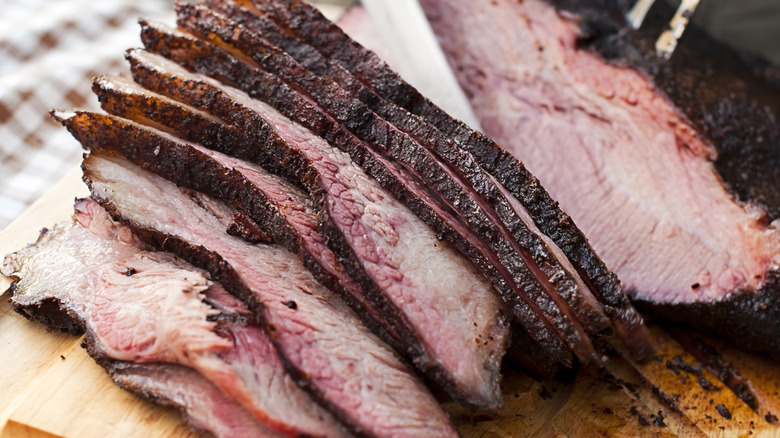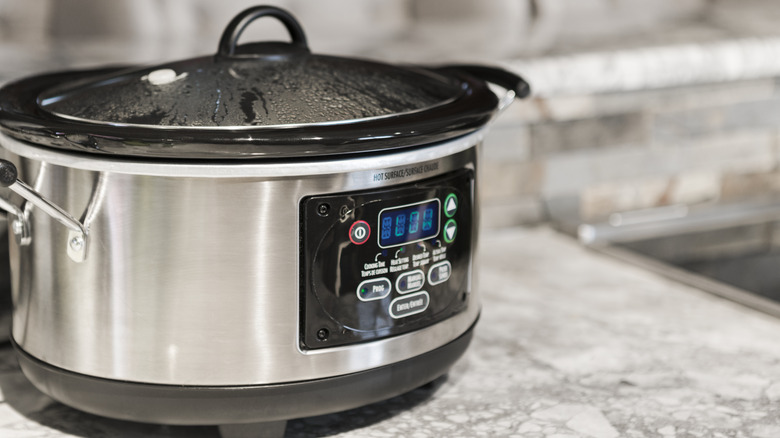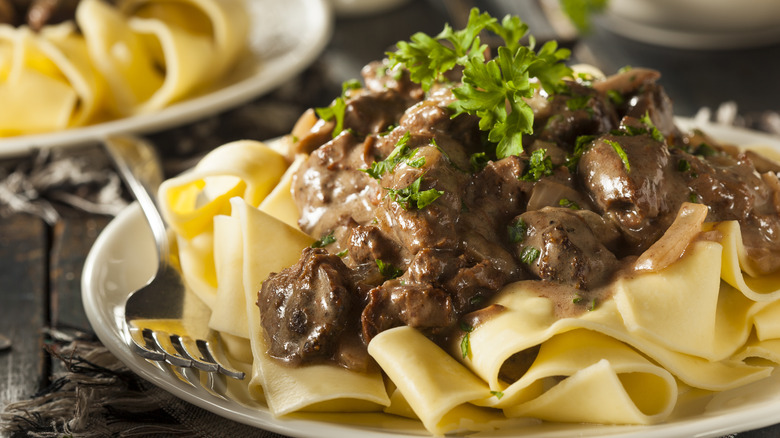The Best Way To Reheat Brisket So That It Stays Juicy
You've already gone through the trouble of smoking your best brisket recipe, but now it's the next day with lots of leftovers. How can you reheat it without messing up the texture or destroying that smoked-for-hours flavor? Low and slow is the key to preserving taste and keeping the meat moist. Using the oven for reheating is one of the easiest methods for serving leftover brisket. It's relatively hands off and can offer consistent results instead of firing up the smoker again, which can have temperature fluctuations depending on conditions.
One thing to note is that when you're initially enjoying your brisket, only slice off what you plan on immediately serving. It's much easier to reheat a large piece of brisket instead of slices, since the latter tends to dry out faster. The same rule goes for reheating your brisket: Only warm up what you want to eat right in the moment for ideal taste and texture.
Once you've determined how much meat you would like to reheat, place it in foil to lock in the moisture. Drizzle on a few spoonfuls of leftover brisket juices, beef broth, apple juice, or even beer for extra hydration, then wrap everything up. The added liquid along with the foil trapping in the steam will ensure that your brisket remains perfectly tender through the entire reheating process. Bake at 325 degrees Fahrenheit for about 45 minutes, or until the brisket's temperature reaches 165 degrees Fahrenheit. Then you're ready to serve!
Other ways to reheat brisket
The oven is the preferred way to reheat brisket. However, if you don't want to warm up the entire kitchen, or your oven is on the fritz, there are other methods to make delicious leftovers. The main rule is just don't ever microwave your brisket. While a quick zap might be tempting, the microwave will steam out any moisture from the meat and leave you with a dry and chewy dish that will be disappointing.
The slow cooker is a great option for reheating brisket as it's the ultimate low and slow kitchen appliance. Place the brisket (either whole or cut into large pieces to fit) inside with any leftover drippings. If you're low on drippings, or just want more of an amped up flavor, use a cup of barbecue sauce or beef stock to keep everything moist. Cook on the low setting for four to six hours, or until the brisket reads 165 degrees Fahrenheit on a probe thermometer.
Sous vide is also an excellent technique for reheating brisket — and is likewise a favorite for reheating roast beef without losing any tenderness. Just place the leftover meat in a sous vide bag with either leftover drippings or a little beef tallow. Then, cook in a sous vide water bath at 165 degrees Fahrenheit for one to two hours, or until the temperature reaches 165 degrees Fahrenheit in the thickest part of the meat
Ways to use leftover brisket
Now that you've successfully reheated your brisket, it's time to enjoy that delicious cut of meat. Of course, it's tasty as-is or with some barbecue sauce on the side for dipping, but if you want to get even more creative, there are plenty of ways to cook with it. Start the day off with a smoky brisket breakfast sandwich, loaded up with eggs and cheese on sturdy bread. Or, stick with the sandwich idea and stack it with creamy slaw and tangy pickled onions for a balance of flavors.
Smoked brisket would also fit in perfectly with some Tex-Mex dishes — this culinary style has a long tradition of smoking meats, such as barbacoa, so it only makes sense to use leftover brisket here too. Chop up or slice some of it to roll into enchiladas, sprinkle atop nachos, or tuck into tortillas for tacos.
Lastly, there are classic comfort foods that could benefit from the addition of leftover brisket, too. Shred or chop some meat to bake a shepherd's pie or stir into a pot of beef stroganoff. You can also dress up a recipe of beef and barley soup with brisket as a smoky inclusion, or create an ultra flavorful chili as the base. The best part of using leftovers for soup? You can easily freeze a batch to enjoy your brisket even months after smoking it.



